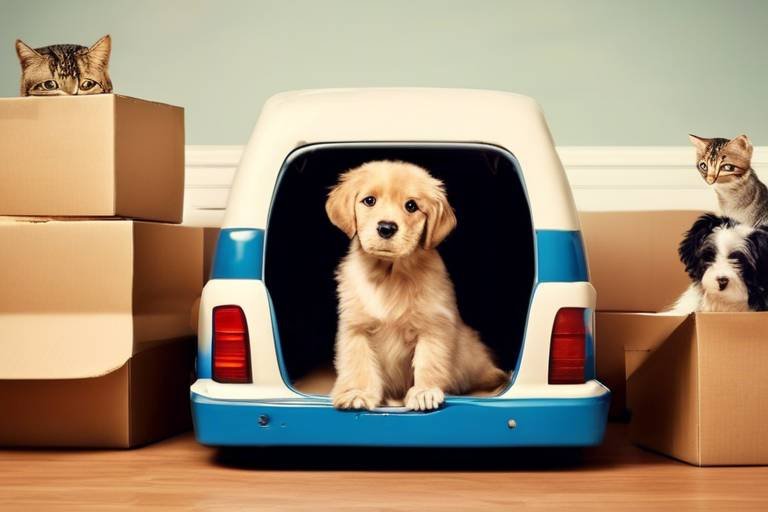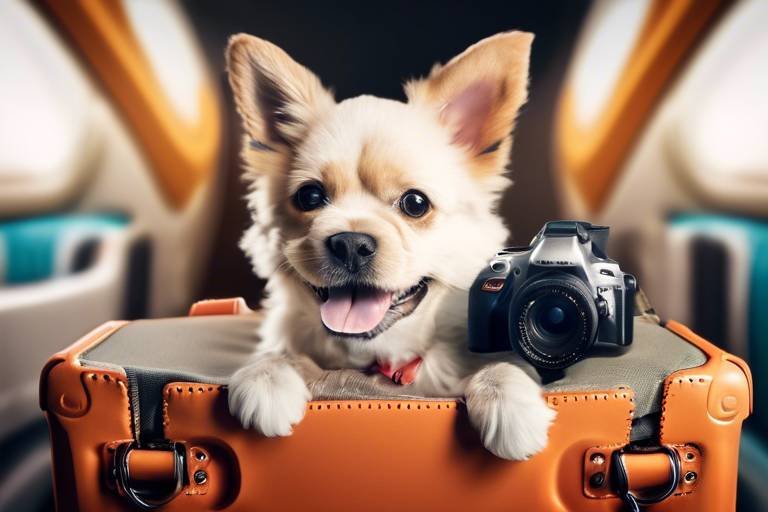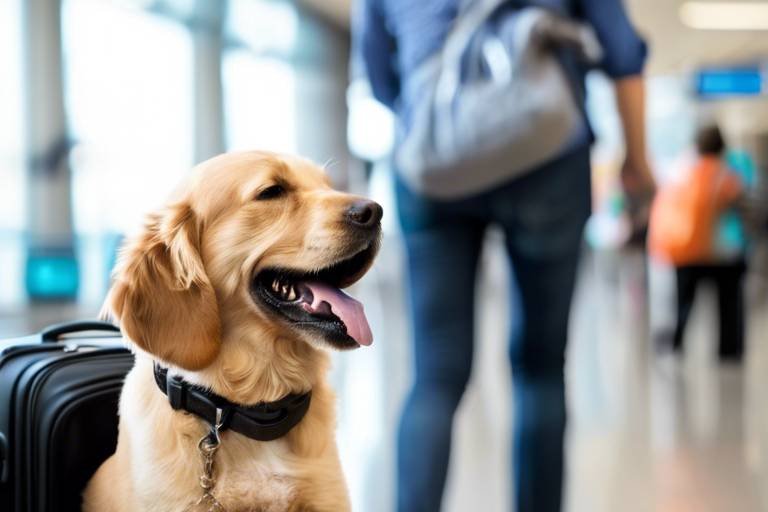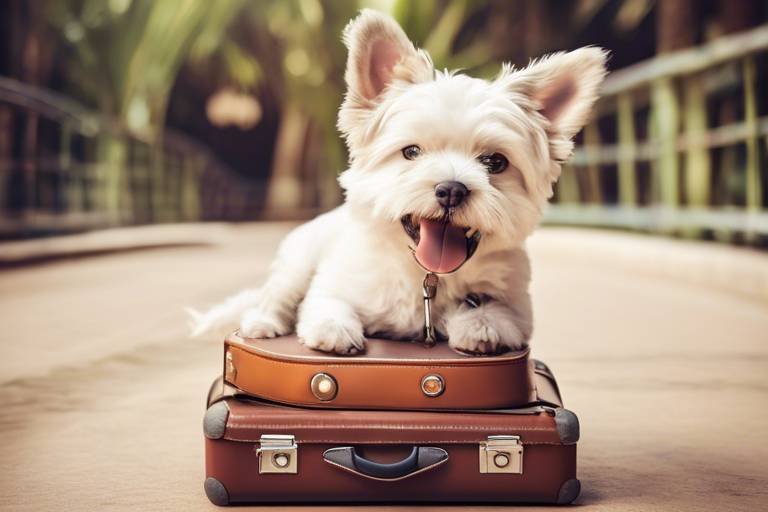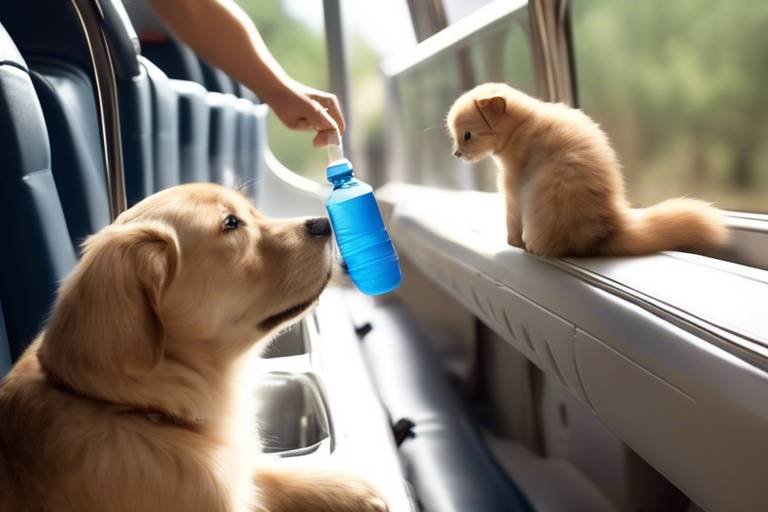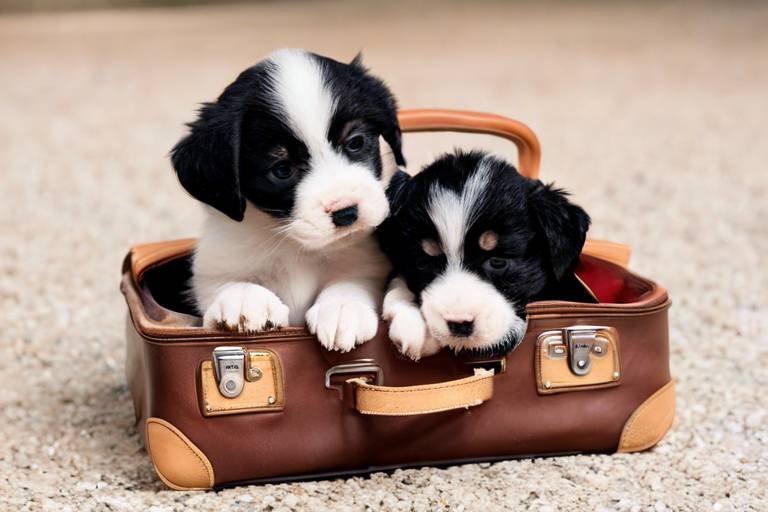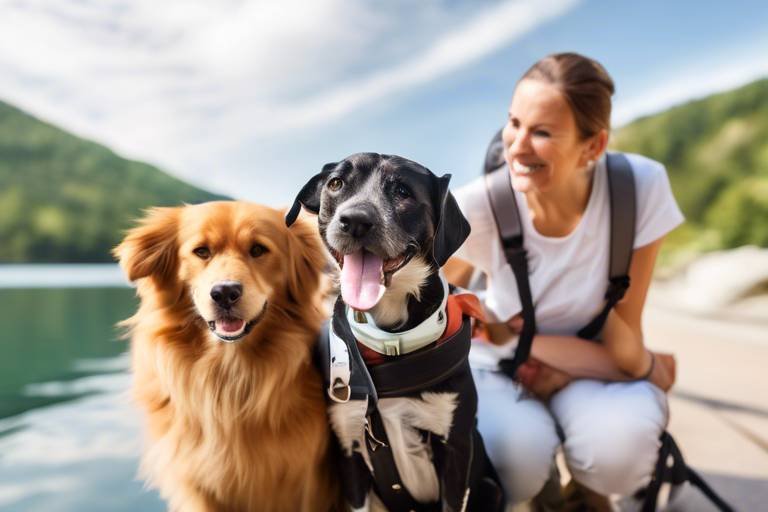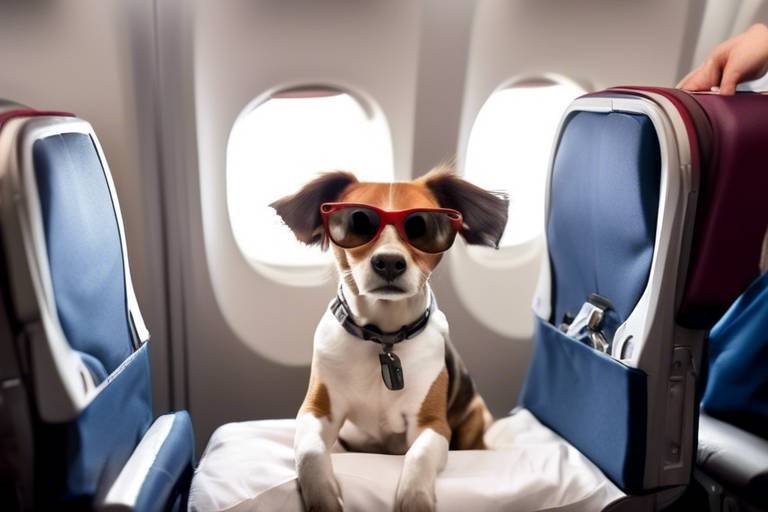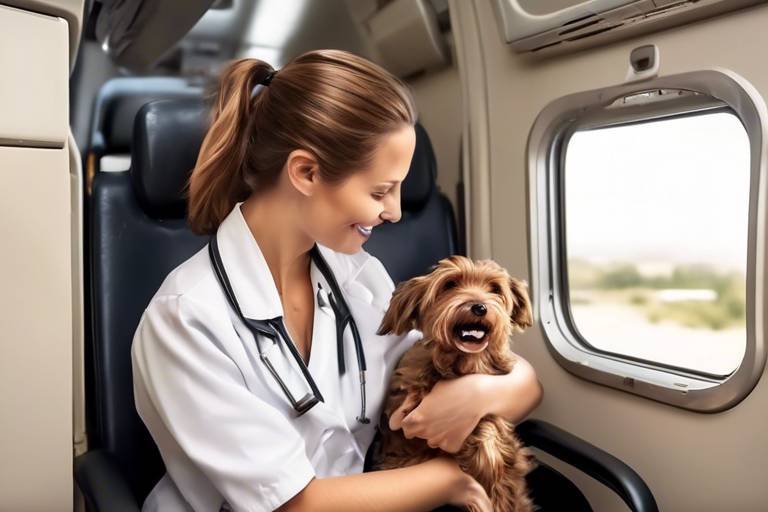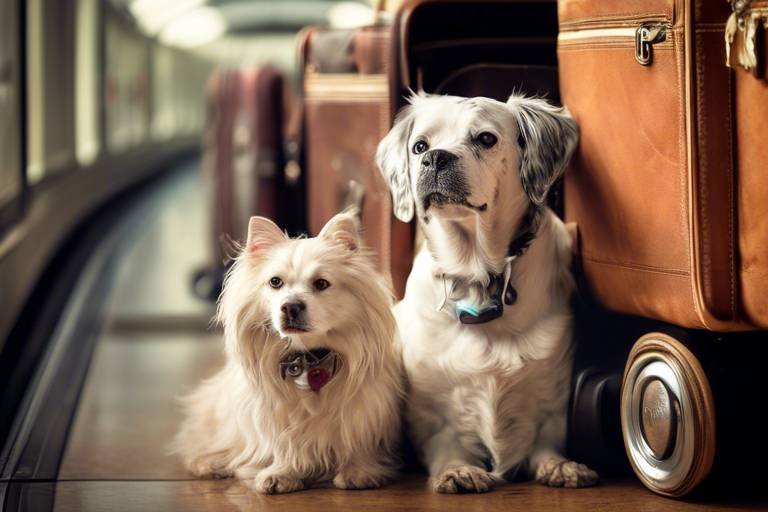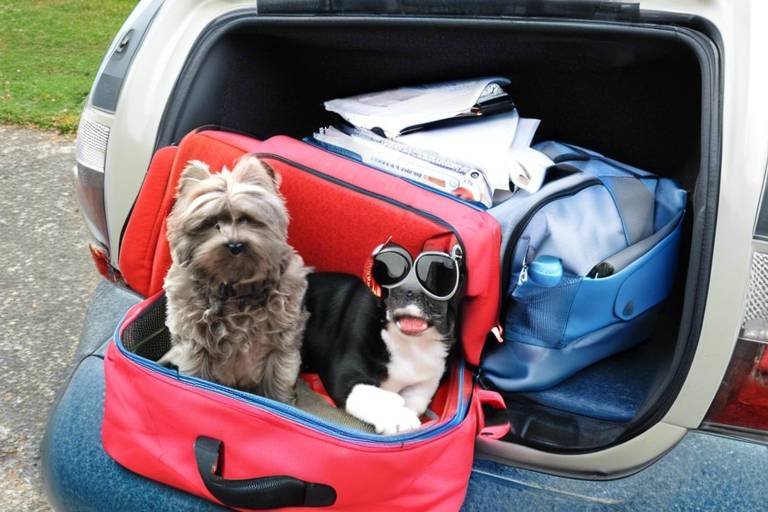How to Communicate Your Pet's Needs While Traveling
Traveling with your furry friend can be an exhilarating experience, but it also comes with its own set of challenges. As a pet owner, you want to ensure that your beloved companion is comfortable, safe, and happy throughout the journey. To achieve this, effective communication of your pet's needs is essential. This article explores various strategies that will help you understand your pet better and ensure their needs are met while you travel together.
Recognizing your pet's body language and vocalizations is crucial when you're on the move. Just like humans, pets express their feelings through various signs. For instance, a wagging tail might indicate excitement, while a tucked tail could signal fear or discomfort. By paying close attention to these cues, you can gauge how your pet is feeling during the trip.
Common signs of stress or discomfort include:
- Panting: This can indicate anxiety or overheating.
- Whining or barking: Excessive vocalization may suggest distress.
- Restlessness: If your pet can’t settle down, they might be feeling uneasy.
Understanding these behaviors allows you to address your pet's needs proactively, ensuring a smoother travel experience for both of you.
Preparation is key to a smooth travel experience. Before you embark on your journey, take the time to plan ahead. This includes packing necessary items, researching pet-friendly accommodations, and ensuring your pet is comfortable with travel. Think of it as packing for a vacation, but this time, your furry friend is the star of the show!
A comprehensive packing list ensures you have everything your pet may need. Here are some must-have items to consider:
- Food and water: Bring enough for the duration of your trip, plus a little extra.
- Leash and harness: Essential for keeping your pet safe during stops.
- Travel crate: A secure space for your pet to relax during long journeys.
By packing these essentials, you're setting the stage for a successful trip where your pet's needs are met.
Keeping your pet healthy and safe is paramount during your travels. This section details the essential health supplies you should bring along:
- Medications: Don’t forget any prescribed medications your pet may need.
- First aid kit: A basic kit can help you handle minor injuries on the go.
- Identification tags: Ensure your pet has proper ID in case they get lost.
These items can make a significant difference in ensuring your pet's health and safety while you're away from home.
Familiar items can ease your pet's anxiety during travel. Bringing along their favorite toys, blankets, or beds can provide a sense of security. Imagine how comforting it is to have a piece of home with you when you're in an unfamiliar place! These comfort items can help reduce stress and keep your pet calm.
Selecting the right mode of transportation can significantly affect your pet's experience. Whether you're driving, flying, or taking a train, each option has its pros and cons. For instance, while traveling by car allows for more flexibility and stops, flying may require more preparation and adherence to regulations. It's essential to evaluate what works best for your pet's temperament and needs.
Modern technology offers tools that can help communicate your pet's needs effectively. From GPS trackers to health monitoring devices, these gadgets can provide peace of mind while you're on the road. Imagine being able to check on your pet's location and well-being with just a tap on your smartphone!
Tracking your pet's location and health is easier than ever with monitoring devices. Popular gadgets include:
- GPS collars: Keep track of your pet's location in real-time.
- Activity monitors: Track your pet's activity levels and health metrics.
These devices not only keep you informed but also help you respond quickly if your pet shows signs of distress.
Mobile applications can facilitate communication and care for your pet while traveling. There are various apps designed to help you manage your pet's needs during travel, such as:
- Pet care management apps: Keep track of appointments, medications, and dietary needs.
- Pet-friendly travel apps: Find pet-friendly accommodations and activities along your route.
These tools can make your travel experience smoother and more enjoyable for both you and your furry companion.
Q1: How can I tell if my pet is stressed while traveling?
A1: Look for signs such as panting, whining, or restlessness. These behaviors can indicate discomfort or anxiety.
Q2: What should I pack for my pet when traveling?
A2: Essential items include food, water, medications, a first aid kit, and comfort items like toys or blankets.
Q3: Are there any apps that can help me care for my pet while traveling?
A3: Yes, there are many apps available for pet care management and finding pet-friendly accommodations.
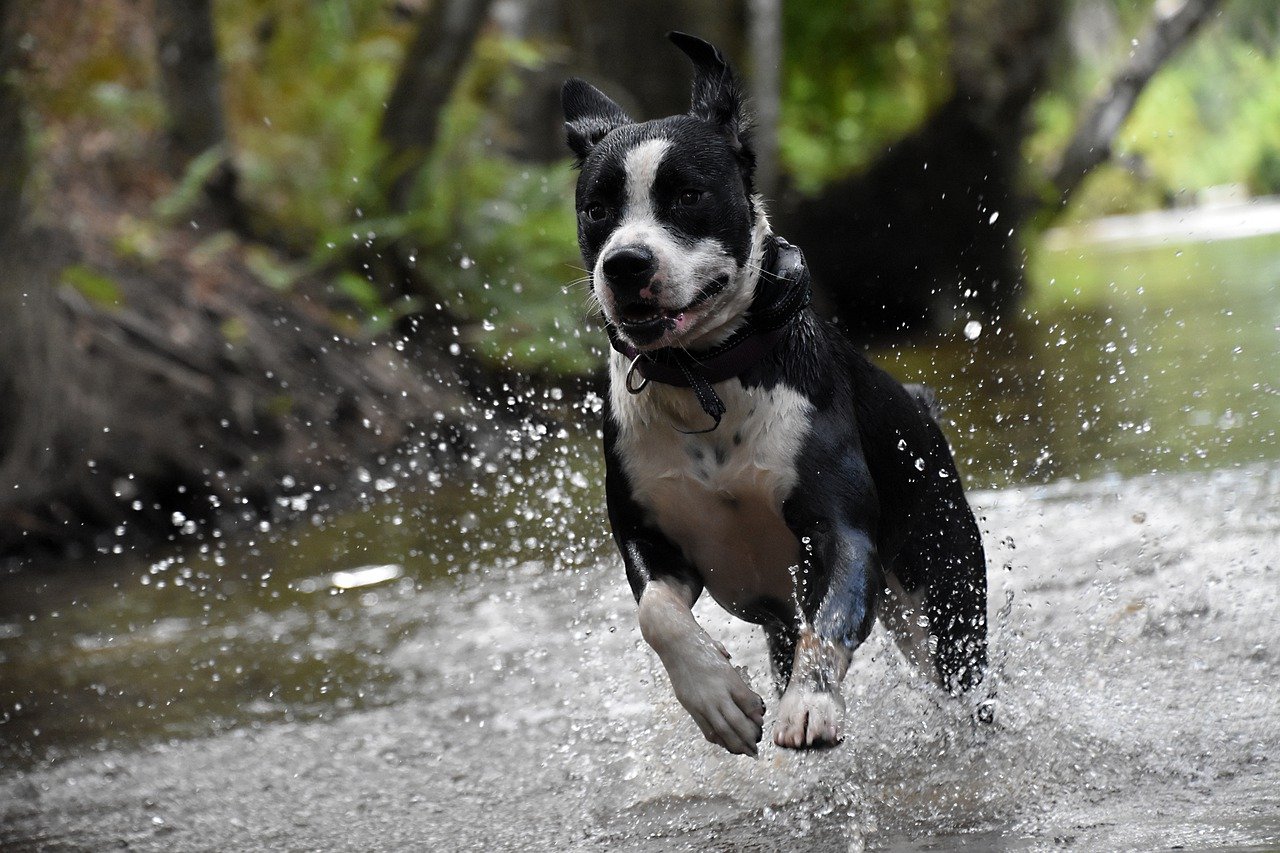
Understanding Your Pet's Behavior
When it comes to traveling with your furry friend, understanding their behavior is crucial. Just like us, pets have their own unique ways of expressing emotions, and being able to read these signs can make all the difference in ensuring their comfort and happiness during your journey. Think of it as learning a new language—once you grasp the basics, communication becomes much smoother.
One of the first things to observe is your pet's body language. For example, a wagging tail can indicate excitement, but did you know that the position of the tail can reveal a lot about their mood? A high, stiff tail may signal alertness or anxiety, while a low tail could mean submission or fear. Similarly, ears that are perked up often show curiosity, while ears that are pinned back can indicate stress or discomfort. By paying attention to these subtle cues, you can gauge how your pet is feeling as you travel.
Vocalizations also play a significant role in understanding your pet's needs. Dogs may bark to express excitement, anxiety, or even a desire for attention, while cats might meow or purr to communicate different feelings. It's essential to differentiate between these sounds—an excited bark is quite different from a distressed yowl. By tuning into these vocal signals, you can respond appropriately, whether that means offering comfort or giving them a bit of space.
Here are some common signs of stress or discomfort that you should watch out for:
- Excessive panting: This can indicate anxiety or overheating.
- Whining or meowing: Often a plea for attention or a sign of distress.
- Restlessness: Pacing or inability to settle down can signal discomfort.
- Avoidance behavior: Hiding or turning away from you may indicate fear.
Understanding these behaviors allows you to take proactive measures. For instance, if your dog is panting heavily and seems restless, it might be time to take a break from the car or provide some water. The key is to establish a connection with your pet and be responsive to their needs, making the journey enjoyable for both of you.
In addition to body language and vocalizations, consider your pet's past experiences. If they have traveled before, they might have developed certain preferences or aversions. For example, a pet that had a negative experience on a plane might show signs of anxiety when faced with similar travel conditions. Being aware of these past experiences can help you tailor your approach to their comfort during the trip.
In summary, understanding your pet's behavior is an essential skill for any pet owner, especially when traveling. By observing their body language and vocalizations, you can better respond to their needs and create a more enjoyable travel experience. Remember, your pet is your travel companion, and keeping them happy will make your journey all the more rewarding.

Preparing for Travel
When it comes to traveling with your furry friend, preparation is everything. Imagine setting off on a long journey without packing your essentials—it's like going to a party without your favorite outfit! To ensure a smooth experience for both you and your pet, it's vital to plan ahead. Start by creating a checklist of items you will need, and don't forget to include your pet's necessities. This way, you won't find yourself scrambling at the last minute, which can lead to unnecessary stress.
One of the first steps in preparing for travel is to research pet-friendly accommodations. Not all hotels and lodgings welcome pets, so it's crucial to find places that do. Websites like BringFido or Airbnb can be lifesavers, allowing you to filter your search for pet-friendly options. Once you have a place to stay, it's time to think about transportation. Whether you're driving or flying, each mode has its own set of requirements and recommendations for traveling with pets.
Another important aspect to consider is your pet's comfort during the journey. Just like you would pack your favorite snacks and a cozy blanket for a road trip, your pet deserves the same treatment. Bringing along their beloved toys or a familiar blanket can help reduce anxiety and make them feel more at home, even when you’re miles away. Remember, a happy pet means a happier trip for everyone!
Don’t forget about safety! Make sure your pet is secured in a carrier or with a seatbelt harness while traveling in a vehicle. If flying, check the airline's pet policy and ensure you have a suitable carrier that meets their requirements. Additionally, it’s wise to have your pet microchipped or ensure they have a collar with an ID tag that includes your contact information. This simple step can make a world of difference if you accidentally get separated.
Finally, keep your pet's health in mind. Schedule a visit to the vet before your trip to ensure they are up-to-date on vaccinations and to discuss any specific health concerns related to travel. Having a copy of their medical records can also be beneficial, especially if you’re traveling long distances or crossing state lines.
In summary, preparing for travel with your pet involves a combination of research, packing essentials, ensuring safety, and considering their health and comfort. By taking these steps, you can create a travel experience that is enjoyable for both you and your furry companion, making memories that will last a lifetime.
Essential Packing List
When it comes to traveling with your pet, having an is not just a good idea; it's a necessity! Imagine trying to enjoy a scenic road trip while your furry friend is uncomfortable or anxious simply because you forgot their favorite toy or essential supplies. It’s like going on a vacation without your favorite pair of shoes—unthinkable, right? So let’s dive into what you absolutely need to pack to ensure both you and your pet have a delightful journey.
First and foremost, you should consider your pet's health and safety. This includes packing any medications your pet may need, as well as a first aid kit tailored for pets. You wouldn’t want to be in a situation where your pet has a minor injury and you’re left scrambling for supplies. A good first aid kit should include:
- Bandages and gauze
- Antiseptic wipes
- Pet-safe pain relievers
- Thermometer
- Emergency contact numbers
Next, let’s talk about identification tags. Ensure your pet has a collar with an ID tag that includes your contact information. If your pet is microchipped, double-check that the information is up to date. This small step can save you a lot of heartache if your pet gets lost during your travels.
Now, onto the comfort items. Bringing along familiar belongings can significantly ease your pet's anxiety. Think about their favorite toys, a cozy blanket, or even their bed. These items serve as a comforting reminder of home, making it easier for your pet to settle into new environments. Just like how you might want your favorite pillow when staying at a hotel, your pet craves the same level of comfort.
Don’t forget to pack food and water supplies. Make sure to bring enough food for the duration of your trip, plus a little extra in case of delays. A portable water bowl is also a must-have to keep your pet hydrated. If you're traveling by car, consider a cooler to keep their food fresh. It’s all about making sure they have everything they need while on the go!
Lastly, take into account any travel documents that may be required, especially if you're crossing state lines or traveling internationally. This could include vaccination records, health certificates, or proof of ownership. It’s always better to be over-prepared than underprepared!
In summary, having an essential packing list for your pet can turn a potentially stressful travel experience into a smooth and enjoyable adventure. By thinking ahead and packing wisely, you can ensure that your furry companion's needs are met, allowing you both to focus on making memories together.
Health and Safety Supplies
When you're on the road with your furry friend, ensuring their health and safety should be your top priority. Just like you'd pack a first aid kit for yourself, your pet deserves the same level of care. Imagine being in a situation where your pet has an unexpected health issue, and you have nothing on hand to help. It’s a nightmare scenario, right? To avoid such predicaments, let's dive into the essential health supplies you should carry.
First off, medications are a must. If your pet is on any prescribed medication, make sure you have enough for the duration of your trip, plus a little extra just in case. It’s also wise to bring along a copy of your veterinarian’s contact information and any relevant medical records. This way, if you find yourself needing to consult a vet while traveling, you'll have all the necessary details at your fingertips.
Next, consider a well-stocked first aid kit. This kit should include items like antiseptic wipes, bandages, gauze, and any specific medications your pet might need in case of an emergency. You can either buy a pre-made pet first aid kit or assemble one yourself. Here’s a quick list of essentials you should include:
- Antiseptic wipes
- Bandages in various sizes
- Gauze rolls
- Pet-safe pain relievers
- Hydrogen peroxide (for cleaning wounds)
- Thermometer
- Emergency contact numbers
Don’t forget about identification tags. If your pet gets lost, having a tag with your contact information is crucial. It’s like giving your pet a lifeline. Consider also using a microchip for added security. This tiny device can be a game-changer if your pet wanders off in an unfamiliar place.
Lastly, always keep your pet's vaccination records handy. Some places may require proof of vaccinations, especially if you're traveling across state lines or to dog-friendly hotels. Having these documents ready can save you a lot of hassle and ensure your pet is allowed everywhere you go.
In summary, packing the right health and safety supplies can make all the difference in ensuring a smooth and enjoyable journey for both you and your pet. It's all about being prepared and proactive. So, before you hit the road, take a moment to gather these essential items and travel with peace of mind!
Q: What should I do if my pet gets sick while traveling?
A: If your pet shows signs of illness, contact a local veterinarian immediately. Having a list of veterinarians in the area can expedite this process.
Q: How can I keep my pet calm during travel?
A: Bring along familiar items like their favorite blanket or toy, and consider using calming aids recommended by your veterinarian.
Q: Should I feed my pet before traveling?
A: It's best to feed your pet a few hours before departure to avoid motion sickness. Always have water available during your journey.
Q: Are there any travel restrictions for pets?
A: Yes, some hotels and transportation services have specific pet policies. Always check in advance to ensure a smooth experience.
Comfort Items
When it comes to traveling with your furry friend, ensuring their comfort is just as important as your own. Imagine being in a new environment, surrounded by unfamiliar sights and sounds—it's enough to make anyone feel a little anxious. Now, think about how your pet feels! Bringing along familiar items can significantly ease their stress and make the journey more enjoyable for both of you. So, what should you pack to create a sense of security for your pet? Let's dive into some essential comfort items that can transform your travel experience.
First and foremost, consider packing your pet's favorite toys. These toys are not just playthings; they are a source of comfort and familiarity. Whether it’s a squeaky toy, a plush companion, or a simple ball, having something that smells like home can help alleviate anxiety. When your pet feels a bit overwhelmed, a quick game of fetch or a cuddle with their favorite toy can work wonders in calming their nerves.
Next up, don’t forget to include a blanket or bed that your pet loves. This item can provide a cozy spot for them to curl up in, whether you're in a hotel room or your vehicle. A familiar blanket can also carry the comforting scents of home, creating a safe haven for your pet wherever they are. If your pet has a preferred sleeping arrangement, like a specific bed, try to bring that along if space allows. It’s all about making them feel as if they haven’t left their comfort zone.
Additionally, consider bringing a travel crate or carrier that your pet is accustomed to. This not only serves as a safe space for them during travel but can also be a cozy retreat when you arrive at your destination. Ensuring that the crate is well-ventilated and lined with their favorite blanket can make it feel like a little home on the go. Remember, the more secure they feel, the more relaxed they will be during your adventures.
Lastly, a water bottle designed for pets is a must-have. Hydration is key, especially during long trips. Many pets can become anxious and forget to drink water, so having a portable water bottle can help keep them hydrated and comfortable. Look for bottles that come with a built-in bowl or a nozzle that makes it easy for your pet to drink on the go.
In summary, packing comfort items for your pet is essential for a smooth travel experience. By bringing along their favorite toys, blankets, beds, and hydration solutions, you can help reduce their anxiety and make the journey enjoyable. Remember, a happy pet means a happy owner, so take the time to prepare and ensure your furry friend feels right at home, no matter where your travels take you!
- What items should I bring for my pet's comfort during travel? It's important to pack your pet's favorite toys, a familiar blanket or bed, a travel crate, and a portable water bottle to ensure their comfort.
- How can I help my pet adjust to new environments while traveling? Bring familiar items from home, provide them with a safe space, and give them time to explore their new surroundings at their own pace.
- Can I use calming products for my pet during travel? Yes, there are various calming products, such as sprays or treats, designed to reduce anxiety in pets during travel.
Choosing Pet-Friendly Transportation
When it comes to traveling with your furry friend, the mode of transportation you select can make a world of difference in their comfort and overall experience. Whether you're planning a road trip or flying across the country, understanding the nuances of each transportation option is essential. For instance, traveling by car often allows for the most flexibility. You can make frequent stops, ensuring your pet can stretch their legs, hydrate, and relieve themselves as needed. Plus, having your pet in the back seat means you can keep an eye on their behavior and comfort level throughout the journey.
On the other hand, if you’re considering air travel, it’s vital to check the airline’s pet policy well in advance. Many airlines allow pets in the cabin, provided they meet certain size requirements. However, some may require your pet to travel in the cargo hold, which can be stressful for both of you. It’s essential to weigh the pros and cons of flying with your pet versus driving. For example, while flying is faster, it can be more stressful for pets due to the unfamiliar environment and noise. Conversely, road trips can be a bonding experience, allowing you to explore new places together.
Before making a decision, consider your pet’s personality. Is your dog a seasoned traveler, or do they get anxious in new environments? Cats, on the other hand, may prefer the quiet confines of a car rather than the hustle and bustle of an airport. It’s also important to prepare your pet for the chosen mode of transportation. For car trips, practice short drives to help them acclimate. For air travel, consider booking a direct flight to minimize stress and avoid layovers that could prolong the journey.
Additionally, here are some factors to keep in mind when choosing pet-friendly transportation:
- Duration of Travel: Long journeys can be taxing for pets. Ensure you plan breaks during road trips and check for layovers if flying.
- Pet Size and Breed: Some transportation methods may have restrictions based on your pet’s size or breed. Always check ahead.
- Health Considerations: If your pet has health issues, consult your vet to determine the best travel option.
In conclusion, choosing the right transportation for your pet is a crucial step in ensuring a smooth and enjoyable journey. By considering their comfort and needs, you can make informed decisions that will help create lasting memories on your travels together.
Q: What should I do if my pet gets anxious during travel?
A: It's essential to prepare your pet for travel by gradually exposing them to the car or carrier. You can also consult your veterinarian about calming products or medications.
Q: Can I take my pet on public transportation?
A: Many public transportation systems have specific pet policies. Check the regulations of the transportation service you plan to use to ensure compliance.
Q: How can I keep my pet safe while traveling?
A: Use a pet seatbelt or carrier during car rides, and always ensure they are securely restrained. For air travel, invest in an airline-approved pet carrier.

Using Technology for Communication
In today's fast-paced world, technology plays a pivotal role in how we communicate, not just with each other but also with our beloved pets. When traveling, ensuring that your furry friend is comfortable and safe can sometimes feel like a daunting task. Thankfully, advancements in technology have made it easier than ever to monitor and communicate your pet's needs while you're on the go. Imagine being able to check in on your pet's well-being from miles away—it's like having a virtual leash that keeps you connected!
One of the most significant advantages of modern technology is the variety of pet monitoring devices available on the market. These gadgets allow you to track your pet's location and health in real-time, giving you peace of mind as you travel. For instance, GPS collars can help you locate your pet if they wander off, while health monitors can track vital signs and activity levels. This way, you can ensure that your pet is not only safe but also feeling their best during your journey.
Moreover, mobile applications designed specifically for pet care have become increasingly popular. These apps can help you manage your pet's needs seamlessly. From scheduling vet appointments to tracking their meals and medication, these tools are invaluable for pet owners on the move. Some apps even feature a pet journal, allowing you to document your pet's experiences and behaviors, which can be especially useful when communicating with your veterinarian.
Here’s a quick overview of some popular pet monitoring devices and mobile apps:
| Device/App | Features | Best For |
|---|---|---|
| GPS Pet Tracker | Real-time location tracking, activity monitoring | Active pets that love to explore |
| Pet Health Monitor | Tracks vital signs, alerts for irregularities | Pets with health concerns |
| Pet Care Apps | Appointment scheduling, meal tracking, pet journals | All pet owners |
By leveraging these technologies, you can keep a close eye on your pet's needs even when you're not physically present. Imagine being able to check your pet's activity levels while you’re stuck in traffic or ensuring they’ve eaten their meals on schedule. This not only enhances your pet's travel experience but also strengthens the bond between you and your furry friend.
In conclusion, using technology to communicate your pet's needs while traveling is not just a luxury; it's becoming a necessity. With the right tools in your arsenal, you can ensure that your pet remains happy, healthy, and connected to you, no matter where your adventures take you. So, as you prepare for your next trip, consider incorporating these innovative solutions into your travel plans. Your pet will thank you for it!
Q: How can I ensure my pet is comfortable while traveling?
A: Make sure to bring familiar items such as their favorite toys and blankets. Additionally, take frequent breaks during long journeys to allow them to stretch and relieve themselves.
Q: Are there any specific apps you recommend for pet care?
A: There are several great apps available, such as Pet First Aid for health emergencies and Pawtrack for GPS tracking. Choose one that best fits your pet's needs.
Q: What should I do if my pet shows signs of anxiety while traveling?
A: If your pet seems anxious, try calming techniques such as playing soothing music, using anxiety wraps, or offering treats. Consult your vet for additional advice if necessary.
Pet Monitoring Devices
In today's fast-paced world, ensuring your furry friend is safe and sound while traveling can feel like a daunting task. However, with the advent of , you can keep a close eye on your pet's well-being no matter where your adventures take you. These innovative gadgets not only provide peace of mind but also allow you to track vital information about your pet in real-time. Imagine being able to monitor your pet's location, activity levels, and even health metrics right from your smartphone! Isn’t that incredible?
One of the most popular types of pet monitoring devices is the GPS tracker. These small, lightweight devices can be attached to your pet's collar, enabling you to pinpoint their location with just a few taps on your phone. This is particularly useful if you’re in a new place and your pet gets a little too curious. Some GPS trackers come equipped with features such as geofencing, which sends you alerts if your pet strays beyond a designated area. It’s like having a virtual leash that keeps your pet safe!
Another exciting option is the activity monitor. These devices are designed to track your pet's movements and behaviors, providing insights into their activity levels and overall health. For instance, if you’re traveling and notice your pet is less active than usual, you can take proactive steps to address any potential issues. Many of these monitors sync with mobile apps, allowing you to view your pet's data in an easy-to-understand format. It’s like having a personal trainer for your pet, ensuring they stay active and healthy even on the road!
When considering a pet monitoring device, it's essential to look for features that suit your needs. Here are some key factors to keep in mind:
- Battery Life: Ensure the device has a long-lasting battery to avoid interruptions during your travels.
- Durability: Look for rugged designs that can withstand the wear and tear of an active pet.
- Water Resistance: This is crucial if you're traveling to places where your pet might encounter water.
- Real-Time Updates: Opt for devices that provide instant notifications and updates about your pet's status.
Additionally, many of these devices come with health monitoring features, such as heart rate tracking and sleep analysis. This data can be invaluable, especially if your pet has pre-existing health conditions. By keeping tabs on their vital signs, you can make informed decisions about their care while away from home.
In conclusion, investing in can significantly enhance your travel experience with your furry companion. Not only do they provide a layer of security, but they also allow you to be more in tune with your pet's needs. So, before you embark on your next adventure, consider equipping yourself with one of these fantastic gadgets. Your pet will thank you for it!
1. What is a pet monitoring device?
A pet monitoring device is a gadget that helps you track your pet's location, activity levels, and health metrics, providing peace of mind while traveling.
2. How do GPS trackers work?
GPS trackers use satellite technology to pinpoint your pet's location, which can be accessed through a mobile app on your smartphone.
3. Are activity monitors worth it?
Yes! Activity monitors can provide valuable insights into your pet's health and behavior, allowing you to take proactive steps to ensure their well-being.
4. Can I use these devices for all pets?
Most pet monitoring devices are designed for dogs and cats, but it’s essential to check the specifications to ensure compatibility with your specific pet.
5. What features should I look for in a pet monitoring device?
Look for features like battery life, durability, water resistance, and real-time updates to ensure you choose the best device for your needs.
Mobile Apps for Pet Care
In today's fast-paced world, technology plays a vital role in enhancing our lives, and the same goes for our furry friends. Mobile apps for pet care have revolutionized the way we manage our pets' needs, especially during travel. Imagine having the ability to monitor your pet's health, schedule vet appointments, and even find pet-friendly locations—all from your smartphone! Isn't that amazing?
One of the most popular types of mobile apps is the pet health tracker. These apps allow you to log your pet's daily activities, track their diet, and even record any health issues that may arise. For instance, apps like Pawtrack and Pet First Aid provide comprehensive resources for pet owners, including reminders for vaccinations and medications. This is crucial when you're on the move, as keeping track of your pet's health can easily slip your mind amidst all the travel chaos.
Another fantastic feature of these apps is the ability to find pet-friendly accommodations and services. Apps such as BringFido and DogBuddy can help you locate nearby pet-friendly hotels, parks, and even restaurants. This means you can enjoy your trip without worrying about where your pet will stay or play. Just think about it—no more last-minute searches for a place that welcomes your furry companion!
Additionally, many mobile apps offer social networking features that allow you to connect with other pet owners. This can be a great way to gather tips and recommendations from fellow travelers. For example, you might discover a hidden gem of a pet-friendly café or a local vet who provides excellent care. It's like having a whole community of pet lovers at your fingertips, ready to share their experiences and advice.
To help you navigate through the myriad of options available, here’s a quick comparison of some popular mobile apps for pet care:
| App Name | Features | Platform |
|---|---|---|
| Pawtrack | Health tracking, medication reminders | iOS, Android |
| BringFido | Find pet-friendly hotels, parks, restaurants | iOS, Android |
| Pet First Aid | Emergency care tips, first aid instructions | iOS, Android |
| DogBuddy | Find local pet sitters and dog walkers | iOS, Android |
By utilizing these mobile apps, you can ensure that your pet's needs are met while traveling, allowing you to focus on enjoying your journey. After all, our pets are part of the family, and they deserve the best care possible, even when we're on the go!
- What are the best mobile apps for pet care? Some of the best apps include Pawtrack, BringFido, and Pet First Aid, each offering unique features for pet health and travel.
- Can I track my pet’s health using an app? Yes! Many apps allow you to log activities, track diets, and set reminders for medications.
- Are there apps that help find pet-friendly places? Absolutely! Apps like BringFido and DogBuddy can help you locate accommodations and services that welcome pets.
Frequently Asked Questions
- What are the signs that my pet is stressed while traveling?
Pets can show stress in various ways. Look for signs like excessive panting, whining, pacing, or trying to hide. Understanding these behaviors can help you address their needs promptly and make the journey smoother.
- How can I prepare my pet for travel?
Preparation is key! Start by taking your pet on short car rides to get them accustomed to being in a vehicle. Also, make sure to pack their essentials, including food, water, toys, and any medications they might need.
- What items should I include in my pet's travel bag?
Your pet's travel bag should include food and water bowls, enough food for the journey, a leash, waste bags, and a first aid kit. Don't forget their favorite blanket or toy to provide comfort during travel!
- Are there pet-friendly transportation options?
Absolutely! Many airlines and train services offer pet-friendly options. If you're driving, make sure your vehicle is pet-friendly and consider taking breaks to allow your pet to stretch and relieve themselves.
- How can technology help me communicate with my pet while traveling?
There are several devices and apps designed for pet monitoring. GPS trackers can help you keep tabs on your pet's location, while health monitoring devices can alert you to any changes in their well-being during travel.
- What are some recommended mobile apps for pet care during travel?
Some popular apps include 'Pet First Aid' for health emergencies, 'Pawtrack' for GPS tracking, and 'Petcube' which allows you to check in on your pet remotely. These tools can help you manage your pet's needs effectively.
- Can I leave my pet alone in a hotel room?
It's generally not recommended to leave your pet alone in a hotel room for long periods. If you must, ensure they are comfortable and safe, and consider using a pet camera to monitor them while you're away.




